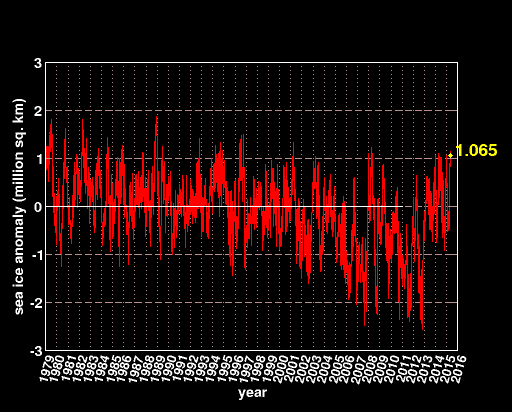As the scumbags at the Guardian tell their readers about unprecedented disappearing ice, the amount of sea ice on the planet approaches record high levels.
Disrupting the Borg is expensive and time consuming!
Google Search
-
Recent Posts
- Fact Checking NASA
- Fact Checking Grok
- Fact Checking The New York Times
- New Visitech Features
- Ice-Free Arctic By 2014
- Debt-Free US Treasury Forecast
- Analyzing Big City Crime (Part 2)
- Analyzing Big City Crime
- UK Migration Caused By Global Warming
- Climate Attribution In Greece
- “Brown: ’50 days to save world'”
- The Catastrophic Influence of Bovine Methane Emissions on Extraterrestrial Climate Patterns
- Posting On X
- Seventeen Years Of Fun
- The Importance Of Good Tools
- Temperature Shifts At Blue Hill, MA
- CO2²
- Time Of Observation Bias
- Climate Scamming For Profit
- Climate Scamming For Profit
- Back To The Future
- “records going back to 1961”
- Analyzing Rainfall At Asheville
- Historical Weather Analysis With Visitech
- “American Summers Are Starting to Feel Like Winter”
Recent Comments
- arn on Fact Checking NASA
- Gordon Vigurs on Fact Checking NASA
- Bob G on Fact Checking NASA
- Bob G on Fact Checking NASA
- arn on Fact Checking NASA
- conrad ziefle on Fact Checking NASA
- conrad ziefle on Fact Checking NASA
- arn on Fact Checking NASA
- Bob G on Fact Checking NASA
- Bob G on Fact Checking NASA



Thanks Tony, time to adjust the raw data! Most of the ice is rotten – 2 m thick and almost gone. Uuups that was my SUV …. again.
Steven, the NSIDC is portraying April 2015 as the “Second Lowest Arctic Sea Ice Extent Ever”…
http://nsidc.org/arcticseaicenews/
How would you respond to this??
I don’t frankly even understand why to use extent instead of an area.
If I drop three coins on on the floor, the area they cover is a few square centimeters, but their extent might be several square meters. Saying “the extent of coins in my room is 15 square meters” doesn’t really tell us anything about how many coins there are.
The arctic sea ice area is nowhere near lowest: http://arctic.atmos.uiuc.edu/cryosphere/arctic.sea.ice.interactive.html
The use of extent and the use of thickness allows lies to be told.
When the winds have caused the ice to pile up into thick piles – Use extent and cry the Ice is melting.
When the winds cause the ice to spread out over a large area use average thickness and cry the Ice is melting.
I think you just answered your own question in the second paragraph.
This is global sea ice. Arctic ice is down, Antarctic ice is way up. Therefore global total is record.
The other bloggers here know this. We also know that Arctic ice is down less than 10 percent against an anomaly that only spans a few decades. That is not enough information to allow governments to completely subjugate populations to save us based on short-term and manipulated data.
Arctic sea ice is right about where it was this time last year and muti year ice is in greater abundance than it was last year. So net gain.
https://sunshinehours.files.wordpress.com/2015/05/arctic_sea_ice_extent_zoomed_2015_day_125_1981-2010.png?w=1024&h=682
The solar wind is quite strong. It results in lack a pressure anomaly over the southern polar circle and allows for continued rapid growth of sea ice.
http://www.cpc.ncep.noaa.gov/products/stratosphere/strat-trop/gif_files/time_pres_HGT_ANOM_AMJ_SH_2015.gif
http://arctic.atmos.uiuc.edu/cryosphere/antarctic.sea.ice.interactive.html
Comparison of ice and snow cover in the Northern Hemisphere on May 5th, 2014 and 2015.
http://igloo.atmos.uiuc.edu/cgi-bin/test/testimage.2.sh?first=20140505.jpg&second=20150505.jpg